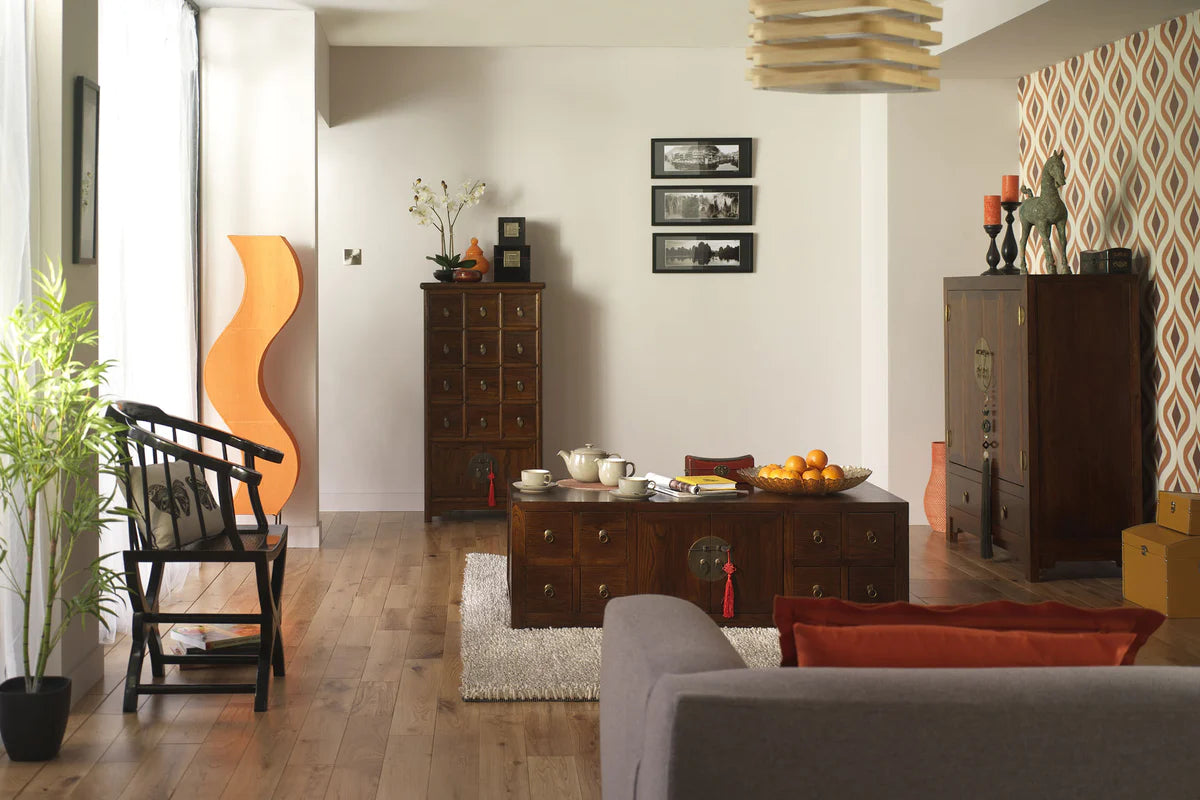Modern Chinese Interior Design
Modern Chinese interior design is a seamless blend of time-honoured tradition and contemporary practicality, offering a distinctive approach to creating harmonious and functional living spaces. At its core, this design philosophy prioritises balance, simplicity, and a deep connection to nature, values that resonate strongly in the fast-paced, cluttered lives many of us lead today.

By drawing from principles like Feng Shui and Zen-inspired order, modern Chinese interiors create environments that feel both calm and purposeful. This approach doesn’t merely replicate historical aesthetics; instead, it adapts them to suit modern lifestyles, making it possible to bring a sense of serenity and thoughtful design into any home. With its focus on decluttering, natural materials, and clever use of space, modern Chinese interior design remains both practical and timeless, appealing to those seeking not just beauty but also balance in their surroundings.
Traditional Foundations in a Modern Context
Modern Chinese interior design draws heavily on centuries-old principles, seamlessly incorporating them into contemporary living. At the heart of this approach lies Feng Shui, an ancient practice centred on harmonising energy within a space. While often associated with the meticulous placement of objects, its broader goal is to foster a sense of balance and flow, qualities that remain vital in today’s fast-paced world.
Zen philosophy also plays a key role, emphasising simplicity and mindfulness in design. This manifests as an aversion to unnecessary ornamentation and a focus on purposeful, functional elements. While these principles are rooted in history, they translate effortlessly into modern interiors, aligning with global trends that prioritise minimalism and wellbeing.
Rather than overwhelming spaces with overt traditional motifs, modern Chinese interiors reinterpret these ideas subtly, using them to inform layouts, materials, and design choices. This approach allows the essence of tradition to coexist with the demands of modern life, creating homes that are both culturally rich and effortlessly contemporary.
The Role of Simplicity in Chinese Interior Design
Simplicity is at the heart of modern Chinese interior design, reflecting a cultural belief that a clutter-free environment promotes harmony and wellbeing. This ethos aligns with global trends favouring minimalism, but its roots are deeply tied to traditional Chinese philosophy, where the placement and purpose of each object contribute to the energy of a space.
In Chinese interiors, every item is chosen for its function and meaning, avoiding the accumulation of unnecessary possessions. This approach ensures that rooms feel open, calm, and thoughtfully composed. The practice of decluttering, while celebrated in modern minimalism movements, has long been an integral aspect of Chinese design, stemming from the belief that physical order encourages mental clarity.
The result is a home where each piece serves a purpose, whether practical or aesthetic, and where the absence of excess creates a sense of balance. By focusing on simplicity, modern Chinese interior design offers an antidote to the chaos of everyday life, creating spaces that feel restorative and intentional.

Nature at the Heart of Design
Modern Chinese interior design places a strong emphasis on natural materials, reflecting a deep respect for the natural world and its influence on wellbeing. This connection to nature is not just aesthetic but philosophical, rooted in the belief that incorporating organic elements into our homes fosters harmony and balance.
Materials such as wood, bamboo, and stone are frequently used, both for their beauty and their ability to bring a calming, grounded quality to a space. These elements are often showcased in their natural forms, with minimal treatment to preserve their authenticity. For example, a wooden dining table might display its natural grain, or a stone ornament might retain its raw texture, serving as a focal point that connects the room to the earth.
This commitment to nature extends beyond materials to the overall ambience. Plants are commonly used, not merely as decoration but as living symbols of growth and vitality. By integrating these natural components, modern Chinese interiors create a sanctuary-like environment, offering a retreat from the stresses of modern life and reminding us of our connection to the world around us.
Balancing Open Spaces with Functionality
Modern Chinese interior design strikes a balance between open-plan layouts and defined spaces. While open spaces are ideal for creating a sense of airiness, the Chinese tradition of functional zones ensures practicality and comfort. Decorative screens, a hallmark of Chinese design, are often used to subtly divide rooms into distinct areas for relaxation, work, or dining without sacrificing openness.

This broken-plan approach reflects a practical blending of tradition with modern needs. Screens and partitions add structure while maintaining flow, enabling homes to feel spacious yet intimate. This method is particularly appealing for creating adaptable, multi-purpose spaces in today’s homes.
Design Elements and Furnishings
Furniture in modern Chinese interiors focuses on clean lines, symmetry, and functionality. Pieces are often crafted from natural materials like wood and bamboo, reflecting the broader design ethos of connecting with nature. Low-profile furniture, such as platform beds or simple wooden tables, promotes a sense of calm and grounding.
Decorative elements are minimal yet meaningful, with subtle use of traditional motifs like lattice patterns or calligraphy-inspired designs. The overall aesthetic avoids excess, instead favouring understated elegance and practicality. This careful curation creates a space that is both timeless and deeply rooted in Chinese cultural identity.
Making It Your Own
Incorporating modern Chinese interior design into your home doesn’t require a complete overhaul. Start small by introducing key elements like natural materials—wooden furniture, bamboo accents, or stone decor can immediately evoke a sense of grounded serenity. Decorative screens or dividers are another practical way to reimagine open spaces, adding structure while maintaining flow.
Focus on decluttering and ensuring every item serves a purpose. A carefully chosen piece of traditional Chinese pottery or a simple rug made from natural fibres can add subtle cultural touches. By embracing these principles, you can create a space that feels personal, balanced, and authentically yours.
Black Lacquer Furniture | Blue and White Ginger Jar | Chinese Artwork | Chinese Tableware | Buddha Head | Green Chinese Ginger Jar | Chinese Blue Lamp | Oriental Rugs | Oriental Cabinet | Chinese Sideboards | Mango Furniture | Chinese Furniture | Chinese Buddha | Blue Chinese Rug | Large Buddha Statue | Chinese Temple | Dragon Necklace | Second Hand Chinese Furniture | Chinese Coffee Tables | Chinese Medicine Cabinet | Chinese Armoire | Chinese Furniture Birmingham | Chinese Furniture Glasgow | Chinoiserie | Antique Stools | Vintage Chinese Furniture





